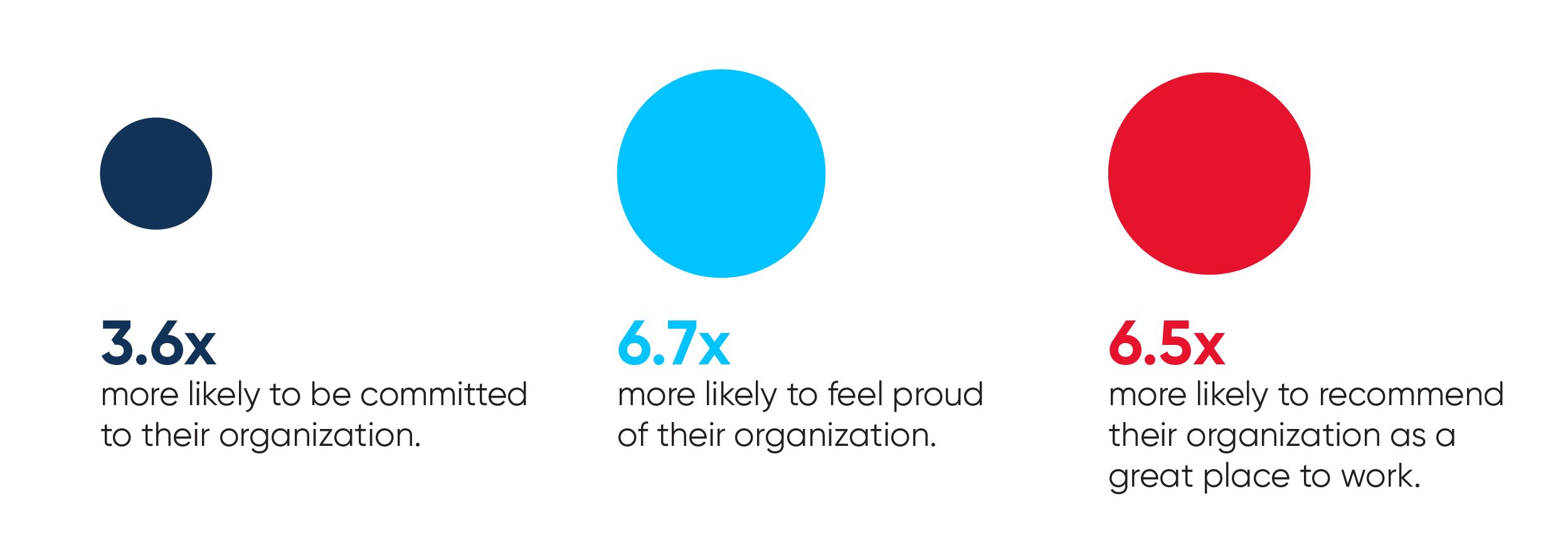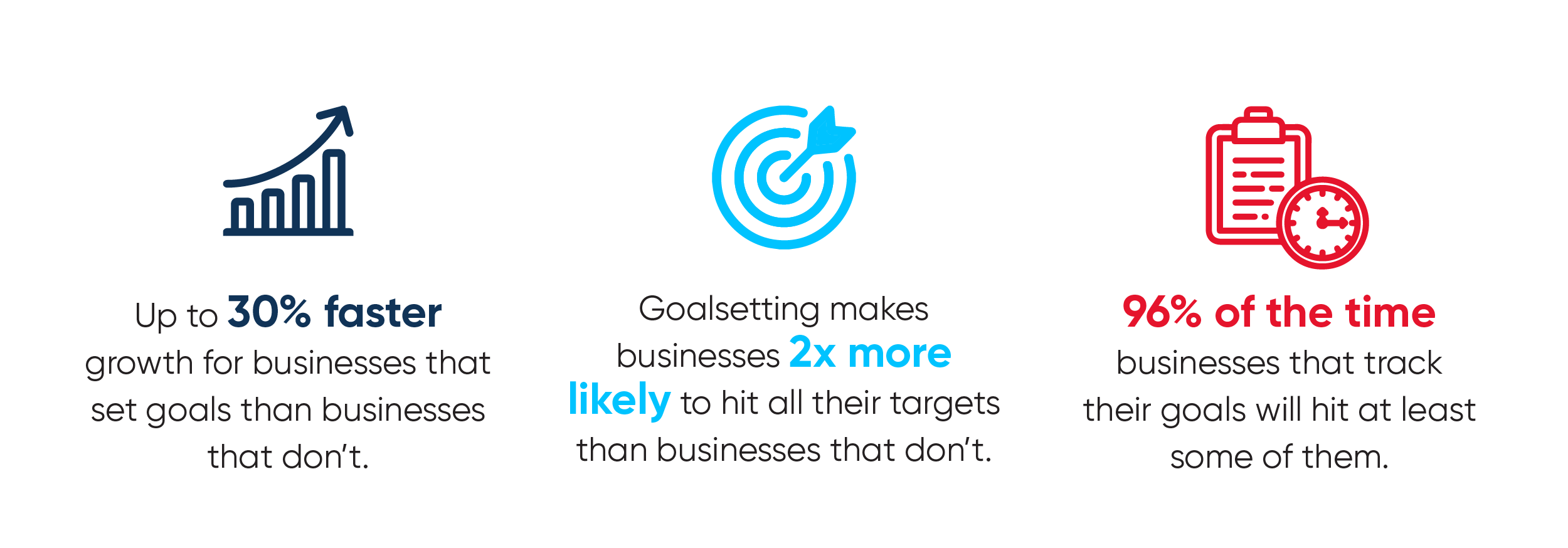Goalsetting is the secret sauce for Management teams to cultivate focus and inspire results. It’s the silent partner that lifts performance throughout the year.
But sometimes goals can be too broad and nebulous, leaving employees unclear or confused.
This article shows you how to zero in on goals that will take your litigation support service business to a bold new level and set you on a winning path the rest of the year.
Ready, Set, Goals!
Zig Ziglar nailed it when he said, “If you aim at nothing, you will hit it every time.”
Goals turn the good into the great. Sure, some business success can be chalked up to luck—maybe as much as 30%—but for most businesses that are serious about growth, goalsetting pretty much mops the floor with luck every time.
That’s because goalsetting is not only controllable, but it is a unifying force that lifts the performance of people and organizations.
Among employees, goalsetting has been shown to pay dividends in three valuable ways. Businesses with clearly expressed goals have employees who are:

Great numbers, right? But to get employees to these thresholds the processes of goalsetting must be sustained over time.
Making that effort over the long haul pays off handsomely, though. Here are just three examples of the rewards goalsetting confers on a business.

The Difference Between Goals, Objectives, Strategies, and Planning
While most business owners and managers know what goals, objectives, strategies and plans mean, sometimes their definitions can differ. Here’s how we’re defining them:
Goals
Goals tend to reflect the longer-term aspirations of a business. They may be broad or speak to “vision”. In 1961 President John F. Kennedy announced a goal to put an American on the moon. Eight years later it happened, employing about 400,000 people in the process.
As a litigation support service provider, you may decide to shift your focus for the new year to improving the company’s finances so a goal could be:
Improve our financial performance.
Objectives
Objectives tend to be specific, measurable milestones, attached to relatively short timelines. They may be measured weekly, quarterly, or by some other short-term interval.
Keep your objectives realistic but ambitious and don’t make them so complex that they can’t be summed up in one sentence.
Good objectives strike a balance between short-term and long-term goals. They can guide goals that are financial as well as non-financial, or those designed for your business’s external or internal stakeholders.
While there are many objectives that can contribute to better financial performance, we will go with the objective of:
Increase cash flow by 20% in Q3.
Strategy
Strategies are the how. They are the higher-level actions or plans that need to be done to achieve the objective. And they don’t have to be complex.
Since the objective is to increase cash flow by Q3, a strategy to support that can be:
By Q2, transition all open credit customer accounts to credit card or ACH to accelerate accounts receivables (and thus, cash flow).
While strategies are invaluable in providing clarity and alignment for teams in the pursuit of goals and objectives, strategy alone won’t deliver a breakthrough without good planning.
Planning
How important is planning in making goals come to life?
Author and businessman Stephen Covey said it best: Goals are pure fantasy unless you have a specific plan to achieve them.
To properly plan, let’s revisit:
| Goal | To improve the company’s financial performance. |
| Objectives | To increase cash flow by Q3. |
| Strategy | To transition all open credit customer accounts to either credit card or ACH by Q2 to accelerate accounts receivables. |
Now our plan can look something like:
- Adopt a new company policy that open credit accounts are no longer available.
- Identify which customers are open credit accounts.
- Email a communication notifying open accounts of the new policy.
- Have Sales follow up with a phone call to answer questions and maintain good relations.
- Ensure all open credit accounts have transitioned to credit card or ACH and monitor impact on cash flow.
- Adjust the plan as needed.
Along with the actionable steps of the plan, deadlines and resources will need to be added. Using a project management tool like Asana, Smartsheet or MS Project can also be useful in creating and managing plans.
A Good Year to Start SMARTNow that we’ve clearly defined objectives, strategy, and planning from a high-level perspective, let’s work on building a properly structured goal that achieves results. We’ll use the SMART goal framework to evaluate whether your goals have the right amount of precision and detail to be effective. |
The SMART framework first appeared in George T. Doran’s 1981 article, There’s a S.M.A.R.T way to write management’s goals and objectives. In his article Doran explains the practical importance of setting goals that are specific, measurable, achievable, relevant, and timebound.
The purpose of the SMART framework was to help management teams set goals and define plans that would improve an organization’s performance.
SMART goals are tailored to eliminate ambiguity from an organization’s operations and provide a blueprint to set objectives.
A litigation support service business that adopts SMART goals can use SMART principles to strengthen its bottom line, especially when it comes to improving resource allocation and refining how teams manage their time.
Let’s break down the SMART goal principles to see them in action.
Specific
Goals won’t be effective unless they identify what must be accomplished, which may be thought of as the “mission statement” of a goal.
A specific goal also clarifies who is involved in achieving the goal (and who is responsible) as well as when the goal should be reached. The outcome of the goal should be clearly expressed so it is understood by anyone.
Measurable
You can’t manage what you can’t measure. SMART provides a yardstick to objectively gage improvements so you can evaluate progress.
The secret to making SMART goals measurable is to include a concrete, quantifiable way to analyze data. In this case, it will be easy to measure whether “all open credit customer accounts” were transitioned and whether cash flow improved.
Attainable
A SMART goal should challenge team members across the organization to stretch. Whether that stretch is a little or a lot, the SMART goal should be ambitious while remaining within the organization’s grasp.
If you’re on the fence about whether the SMART goal you have in mind is attainable, consider whether businesses in the same market of similar size have ever successfully reached the same goal. Ask yourself whether your team has the resources and skill to reach this goal, or if you’ll need to help them tool up?
Relevant
This one can be tricky because “relevant” lives in the shadow of the question, “Relevant to whom?” Is it you, your customer, the courts, or perhaps another provider?
Your goal should also have the higher purpose of aligning with your business’s mission. To gain clarity about the relevance of your SMART goal, ask yourself, “Will achieving this goal improve productivity, help our team members succeed, and lead to greater business success?
Time-Bound
Nothing says “get things done” like a ticking clock, so give your goals a deadline.
Why do deadlines work? There’s plenty of psychology to explain it but one of the well-known magic powers of deadlines is the Scarcity Principle, which says deadlines create a sense of urgency and limited availability. The IRS has used the Scarcity Principle effectively for years by setting Tax Day as April 15th.
Any approach that can get an entire nation mobilized could be considered highly effective.
Remember, setting a completion date in SMART goals doesn’t mean things halt once the date arrives. It simply signals it’s time to evaluate your efforts.
SMART Goals Thrive on Data
The “measurable” and “timebound” elements of SMART goals naturally imply a need for data. Therefore, as you build your SMART goal, consider which data you’ll use to keep your goals measurable and reportable.
You’ve probably already got data sources within your own business you can use to build and launch a SMART goal. To help you visualize how this works, let’s work with a data source many businesses commonly use: Net Promoter Score (NPS).
Many businesses use NPS data to gage customer satisfaction. A litigation support service business that captures NPS data can feed that data through the SMART goal framework to find a strategic opportunity and develop a goal.
Here’s one way to do that.
Let’s say your current NPS data indicates a customer satisfaction score of 30. That’s a good score, however, if you want to hover closer to Apple’s lofty NPS of 61, your goal for the new year might be: to reach an NPS of 60 by year end.
Broken down in the table below, you can see how this goal matches up to each dimension of the SMART framework:
|
Specific |
Measurable |
Attainable |
Relevant |
Timebound |
|
Net Promoter Score. |
60 |
Challenging but |
Will matter |
December |
In addition to providing data for goalsetting, NPS insights clarify what it’s like to do business with a company through the eyes of its customers. Each NPS report can potentially provide an opportunity to identify gaps in your services or understand what you’re already doing well so you can do more of it.
It’s a New Year. Carpe diem!
Goalsetting is about being bold and pursuing improvement. It’s about passion and focus. But what if your business falls short of its goals?
It’s not unusual for business goals to miss the mark. It’s been reported that up to 90% of businesses don’t reach their strategic goals, so if your company isn’t hitting every goal directly you may simply need to change how you pursue them.
Take a strategic pause, return to the SMART framework, and ask yourself whether your goal was achievable? Was it too vague? Did the market change and the original goal no longer makes sense?
Make sure you’re measuring the right data points then carry on with new parameters and definitions.
Don’t forget to celebrate the victories and milestones along the way. Anything from a champagne toast to a casual week at the office can be a good way to recognize important progress. You may not have hit a bullseye directly but if the end of the year shows improvement over the first of the year, then you’ve achieved something worth celebrating.
